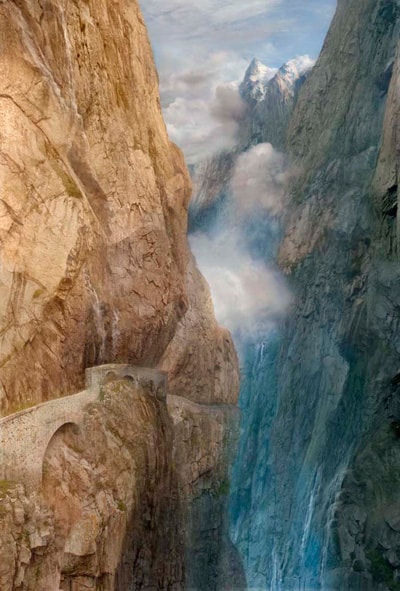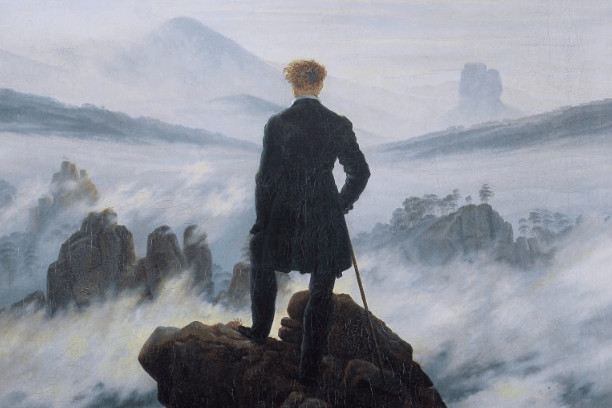Each of us knows the feeling. You’ve climbed long and hard. Perhaps you’ve stood on an icy lip and gazed into the inky blackness of a seemingly bottomless crevasse, hearing bits of ice skid down the smooth sides that offer no purchase. Perhaps you’ve run out a leader-line that’s propped on bad pro like a cheap string of Christmas lights gently but alarmingly swaying in the slightest breeze. Perhaps you’re standing on a thin ledge looking straight down a 2000-meter rock face into another country. We’ve all been there, and we all know the strange and unique combination of euphoria and fear that grips us in such moments.
This specific complex emotion is called ‘the sublime,’ and it has its home in the mountains.
That the sublime would be proper to mountains is unsurprising, for the term was first introduced by the classical Greek rhetorician Longinus to designate an “elevated” style of writing and speech, which was then translated as “sublimis” (“uplifting, lofty”) in subsequent Latin translations of the Greek original text. The concept was rediscovered in the 18th century, where it migrated from a stylistic feature to a sensory experience requiring philosophical and psychological explanation, most famously in Edmund Burke’s A Philosophical Enquiry into the Origin of Our Ideas of the Sublime and Beautiful (1757). There Burke defined the sublime as “that state of the soul, in which all its motions are suspended, with some degree of horror,” a peculiar form of “astonishment in terror” and a “delightful horror.”
He wrote:
No passion so effectually robs the mind of all its powers of acting and reasoning as fear, for fear being an apprehension of pain and death, it operates in a manner that resembles actual pain. Whatever therefore is terrible, with regard to sight too is sublime, whether this cause of terror be endured with greatness of dimension or not.
So whereas the visual apprehension of beautiful objects induces a pleasurable feeling at the balance, harmony, and elegance of the object, what visually appears terrible or infinitely vast induces the painful or unpleasant feeling of fear, and the cause of such a feeling Burke calls “sublime.”
His great successor, Immanuel Kant, deepened the psychological analysis and expanded the philosophical significance of the sublime in his Critique of Judgment (1790). What, asked Kant, distinguishes the feeling of the sublime from simple fear, dread, anxiety, and so on? While fear is actually and wholly painful, the sublime is not; it is mixed with “delight”. Perhaps Kant found an answer to the question in his great predecessor, David Hume, who in A Treatise of Human Nature (1739) asked his reader to consider “the case of a man, who being hung out from a high tower in a case of iron cannot forbear trembling, when he surveys the precipice below him, tho’ he knows himself to be perfectly secure from falling, by his experience of the solidity of the iron, which supports him.”
Kant may well have borrowed this vignette from Hume, whose work exercised him greatly, as one of his examples for what he called “the dynamically sublime”: that in being exposed to something existentially threatening from a location that we nonetheless know to be secure, we both are physiologically caused to feel fear and we intellectually, correctly believe that there is nothing dangerous to be afraid of.
For Kant there was a philosophical, moral lesson to be drawn here: that we experience such moments of the sublime demonstrates that we can transcend the bounds of natural causality and sense the realm of intellectual freedom. The combination of physiological fear and intellectual belief for Kant indicates our dual nature as human beings belonging to both the realm of natural causal necessity and the realm of moral freedom. Thus when we experience the sublime we are most authentically human beings.
So how is the sublime specifically a mountain emotion?
This first great age of the sublime—in art and scholarly, scientific discourse—was also the great pioneering period of mountaineering in the Swiss Alps. Whereas in previous centuries mountains were considered either mortally inhospitable wilderness or the inviolably sacred home of divinities, adventurers and geologists began to climb in the Alps in the 18th century.
On August 8, 1786, the mountain previously called Mont Maudit (“the cursed mountain”) was climbed for the first time and renamed, and rebranded, Mont Blanc. Between 1770 and 1800 the fashionably wealthy participated in the fashion of taking a “Grand Tour” in Europe, which necessarily included a high-altitude hike in the Swiss Alps. These experiences were immortalized and stylized by the illustrious painters and lithographers of the day. J.M.W. Turner, famous for his impressionist portrayals of sublime mountainscapes (figures 1 and 2) toured the Alps in 1802, and Caspar David Friedrich, less interested in realistic landscapes than in the religious idealism of German Romanticism, tried to induce the feeling of the sublime by placing the viewer over the shoulder of the painting’s protagonist (figure 3).

Fig 1: The Schöllenen Gorge from the Devil’s Bridge Pass of St. Gotthard (1802), Turner.

Fig 2: The Passage at Mount St. Gotthard (1804), Turner.

Fig 3: Der Wanderer über dem Nebelmeer (1818), Friedrich.
By the end of the 18th century, one could experience the sublime on a package tour of the Alps like one goes to a roller coaster amusement park today. And in turn, genuine explorers and mountaineers, for whom the feeling of the sublime was an inherent and welcome byproduct of their pursuit rather than merely a manufactured and commercialized commodity to be consumed, pressed higher, farther, up into the wild heights of more distant lands.
The second great age of the sublime in Western culture occurred in the early decades of the twentieth-century, and once again occurred in the mountains, but this time on the film screen rather than the canvas. After the First World War, Europe was convulsed by political and economic forces threatening its existence: inflation and recession, fascist and communist revolutionary movements, and the dearth of able-bodied and able-minded men after the horrors of the so-called Great War.

Fig 4: Die weiße Hölle von Piz Palü (1929), Arnold Fank.
In the midst of the fragile fledgling democracy of Weimar Germany, the film director Arnold Fanck created the new genre of the “Mountain Film” (Bergfilm), self-consciously incorporating the iconography of the earlier German Romantic painters like Caspar David Friedrich. In films such as Mountain of Destiny (1924), The Holy Mountain (1926), and The White Hell of Piz Palü (1929) Fanck created stunning images of vulnerable male climbers exposed to nature’s elemental powers in the mountains (Fig. 4).
Critics have interpreted these films as signs of fascist inclinations, finding in the heroes’ submission to elemental forces “a mentality kindred to Nazi spirit” (Siegfried Kracauer) and “an anthology of proto-Nazi sentiments” (Susan Sontag); indeed, Fanck’s favorite actress, Leni Riefenstahl, directed and starred in her own mountain film (The Blue Light, 1932), which so impressed Hitler that he recruited her for his own cinematic transfiguration (The Triumph of the Will, 1935). But, as film historians have observed, this interpretation omits or understates the fascinating and disquieting pleasure these films provided their huge audiences, a popularity that cannot be explained by the glorious landscapes or the melodramatic plots alone. Rather, the mountain films may also be seen as distinctly sublime embodiments of Weimar and indeed modern anxieties: an enveloping and alarming political obscurity arising from unexpected and rapid changes in technology, economic, and social relations.
Just as a century earlier Kant had argued that the mountain sublime expressed our authentic human nature, the mountain film of the 1920s and 1930s depicted a fantastical image of physically and mentally undamaged, and politically uncompromised men risking their lives while secure in the knowledge of their climbing abilities and hence safety. A fantasy, no doubt, but also a reflection of the widespread disorientation in the great European metropolises at the time on the one hand, and the enduring, salving and centering power of the mountain emotion on the other.
If you liked this article, we think you’ll also enjoy:
- Essay: The Dharma of Dirtbag — Five Principles of Rock Climbing & Buddhism
- Essay: To Suffer Well — An Ode to Grit
- Why I Climb — Subtlety, Meditation, and the Regrettable Elusiveness of Levitation
- Essay: What’s in a Grade? — How to Approach Climbing Difficulty
- Essay: Why I Don’t Free Solo
Lastly, don’t forget to check out our most popular articles ever published, free rock climbing eBooks, and the internet’s best climbing gear sales.








